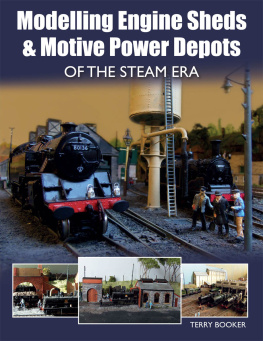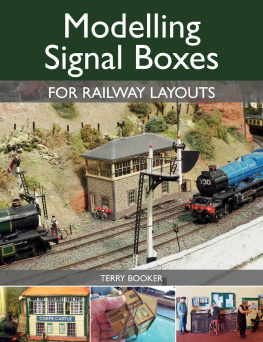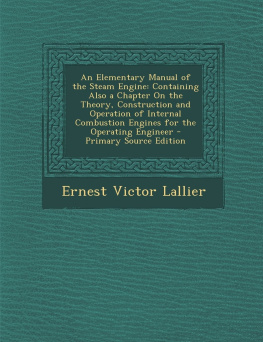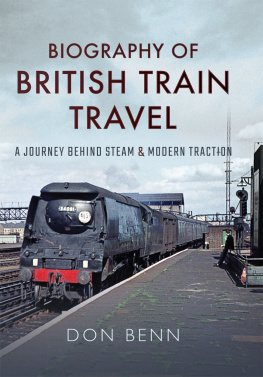
Modelling Engine Sheds
& Motive Power Depots
OF THE STEAM ERA
TERRY BOOKER

THE CROWOOD PRESS
First published in 2016 by
The Crowood Press Ltd
Ramsbury, Marlborough
Wiltshire SN8 2HR
www.crowood.com
This e-book first published in 2016
Terry Booker 2016
All rights reserved. No part of this publication may be reproduced or transmitted in any form or by any means, electronic or mechanical, including photocopy, recording, or any information storage and retrieval system, without permission in writing from the publishers.
British Library Cataloguing-in-Publication Data
A catalogue record for this book is available from the British Library.
ISBN 978 1 78500 115 4
Disclaimer
The author and the publisher do not accept any responsibility in any manner whatsoever for any error or omission, or any loss, damage, injury, adverse outcome, or liability of any kind incurred as a result of the use of any of the information contained in this book, or reliance upon it. If in doubt about any aspect of railway modelling skills and techniques, readers are advised to seek professional advice.
CONTENTS
PREFACE
One of the more difficult tasks facing the railway modeller, or indeed the model railway author, is to try to define the exact time at which the model is set. Its possibly fair to say that this problem is unique to our hobby. Our colleagues who model military subjects certainly have no such difficulties: if their diorama represents the Battle of Hastings, the Battle of the Bulge or the Battle of Gettysburg, then their definitions of time and place are predetermined. Even the Battle of Britain can be pinned down to a matter of weeks and specific locations. The same is true of their single models, where the tank or aircraft belonged to a particular unit or even to a particular officer.
It is not so easy for us who strive to produce realistic models of the steam or early diesel periods. In most cases, though not all, even our locations are hypothetical and our time-span is often defined in years if not decades. This is not made any easier by the simple fact that our chosen subjects were in a constant state of evolution. Many engines reached the scrapyards of the 1960s looking much as they did when they left the factories a half-century earlier, but in the intervening years they may well have worn a dozen or more different liveries. This fact is an undoubted boon to ready-to-run (r-t-r) manufacturers, who can produce scores of new models from their original investment.
These anachronisms are almost inevitable and I must admit that on my own layouts, which ostensibly are set in the decade from 1945 to 1955, Southern engines can appear in pre-war Maunsell livery, Bulleid Malachite Green, early BR blue or post-1956 Brunswick Green with the later crest. Nor are things any better with my ex-GWR, LMS, LNER and BR Standards.
Fortunately most engine sheds tended to look pretty much the same throughout their lives, give or take the odd coat of paint. For this book, at least, we can let the description Steam Era span the whole period from the last years of the Big Four up to the last wisps of steam at end of the 1960s. Indeed, well go even further by giving our motive power depot (MPD) a new lease of life as a contemporary Steam Centre, where you can feature your locomotives in whatever livery you choose.
ACKNOWLEDGEMENTS
It is not long since I was grappling with the problem of what to say in my previous book on modelling goods trains. The difficulty is compounded by the need to avoid repeating myself even while thanking those same kind individuals. However, I must begin by expressing my gratitude to my publishers at The Crowood Press who bravely commissioned this second title almost before the first manuscript had been delivered. Next I cannot allow the immense tolerance, generosity and encouragement of my late parents to pass unacknowledged. Even when times were hard they never failed to foster my love of steam railways and my passion for model-making. How lucky can one get to then have a family of ones own who continued to support the old chap in both these hobbies. My poor wife and my two fine sons have been dragged from one end of the country to another in pursuit of steam. Even our continental holidays meant dampf on the Rhine and not loungers on the Riviera.
For this book in particular I must thank those companies who kindly contributed some of the kits and bits for the many projects, notably Dapol, Scalescenes, Langley, Freestone Models, Sankey Scenics and Model Railway Scenery. The assistance of the archivists who have provided the invaluable, and duly credited, images has helped to anchor the work firmly in the long-past steam era. Finally, and as before, I would like pay tribute to the scores of photographers, authors and publishers who keep us engrossed as readers and inspired as modellers.
(All photographs are the Authors unless otherwise credited.)
INTRODUCTION
Engine sheds are often referred to as Cathedrals of Steam, usually by romantically inclined authors who never had the dubious pleasure of having to work within their dark, dank and dangerous environments. It is true that the shafts of hazy sunlight filtering through the smoke-begrimed windows, recorded for posterity by talented cameramen, sometimes resemble the heavenly beams glimpsed in our magnificent churches, but there the resemblance ends. Just read a few chapters of any enginemans autobiography and any ecclesiastical images will be quickly dispelled. The sheds were Victorian in their origins, Victorian in their practices and the standards of health and safety were certainly Victorian. Our fathers and grandfathers were as unlike us as a Patriot is to a Pendolino. They didnt just endure these primitive working conditions; they thrived amid them and took enormous and justifiable pride in being a part of that elite community of railway servants.

This is the epitome of the Cathedrals of Steam shot, as a veteran pre-grouping 4-4-0 enjoys its twilight years. BEN BROOKSBANK AND LICENSED FOR REUSE UNDER THIS CREATIVE COMMONS LICENCE
In the following chapters I hope to apply some of the creative ethic that is an integral part of the works produced by our fellow military modellers. Irrespective of whether they produce dioramas, set pieces or single subjects, there is always an underlying feeling of tribute to those who fought there or who drove or flew the original machines. That is not to say that they are in any way either pious or precious about their efforts. They simply set great store in their research and do their best to capture some of the atmosphere alongside the undoubted accuracy of their model-making. Without wishing to over-romanticize things and I admit to being a fairly frequent military modeller myself its a bit like a handshake or a salute back in time. Perhaps its a way of saying thank you and keeping the memories alive.
In a short poem Sir Christopher Foxley-Norris described a Battle of Britain pilot as a common, unconsidered man, who, / For a moment of eternity, / Held the whole future of mankind / In his two sweating palms / And did not let it go. I would like to think that bygone generations of enginemen and shed staff merit a similar outlook from railway modellers. They too were ordinary men whose lifetimes work it was to constantly maintain the nations arteries, in all weathers and with machines that were at best primitive and at worst clapped-out. They deserve our respect and admiration and, if we can convey any of this on our layouts, the better modellers we will be.


















